Integrating Laboratory-Measured Contact Angles into Time-Dependent Wettability-Adjusted LBM Simulations for Oil–Water Relative Permeability
Abstract
1. Introduction
2. Methods
2.1. Experimental Procedure
2.2. Image Processing and Contact Angle Measurement
2.2.1. Micro-CT Image Processing
2.2.2. Contact Angle Measurement
- Extraction of oil–water interface regions—From the segmented 3D micro-CT datasets, localized regions containing clear oil–water-rock interfaces were selected. These regions were chosen based on pore-scale features where phase boundaries were well-defined and unaffected by image noise.
- 2D slice generation and binarization—To facilitate geometric analysis, cross-sectional slices perpendicular to the displacement direction were extracted from the selected regions. The oil and water phases were converted into binary representations, highlighting the phase boundaries relative to the rock matrix.
- Interface curvature fitting—The oil–water interface in each selected 2D slice was analyzed using curvature fitting algorithms to determine the tangent at the three-phase contact line. A polynomial or circular fitting method was applied depending on the interface shape, ensuring an accurate representation of the contact angle.
- Angle calculation—The contact angle was measured as the angle between the fitted oil–water interface tangent and the normal vector of the rock surface. This step was repeated across multiple slices within the same flooding stage to obtain a statistically representative average contact angle.
- Correction for resolution and curvature effects—To account for potential distortions caused by image resolution limitations, correction factors were applied based on known calibration standards. Additionally, local surface roughness and mineralogical variations were considered when interpreting contact angle trends.
2.3. Numerical Simulation Using the Lattice Boltzmann Method
- The bounce-back boundary condition was applied at solid boundary nodes to enforce the no-slip condition.
- Periodic boundary conditions were used at flow domain boundaries to maintain continuity. The mirror boundary conditions were tested along the main flow axis, and their influence on the interior flow field and output parameters was found to be negligible.
- At the inlet and the outlet, a static boundary condition [35] was used to control flow pressure.
2.4. Simulation Workflow and Parameter Calibration
3. Results and Discussion
3.1. Observation of the Waterflooding Displacement Process
3.2. Analysis of Waterflooding Efficiency
3.3. Evolution of Wettability and Its Impact on Relative Permeability
3.4. Analysis of Relative Permeability Simulation Results
4. Conclusions
- A key innovation of this study is the experimental validation of the wettability evolution during waterflooding. Micro-CT imaging and displacement experiments confirmed that prolonged water injection gradually shifts the rock wettability by stripping the oil films, dissolving polar crude oil components, and exposing hydrophilic minerals such as quartz and feldspar. Contact angle measurements demonstrated a systematic transition from weakly water-wet to strongly water-wet conditions, with angles increasing from 108° to 128° between 10 PV and 100 PV injection stages, highlighting the dynamic nature of wettability alterations in porous media.
- Another major contribution is the development of a dynamic wettability-adjusted LBM model that incorporates experimentally measured contact angles into numerical simulations. By continuously updating the fluid–solid interaction strength parameter based on experimental data, the model captures real-time wettability transitions and their direct influence on fluid displacement. Comparative simulations showed that neglecting wettability evolution leads to an overestimation of residual oil saturation and an underestimation of water-phase permeability, underscoring the necessity of accounting for the wettability changes in the relative permeability modeling.
- The study also provides new insights into the impact of wettability evolution on relative permeability. By comparing simulations with constant and dynamic wettability, it was found that dynamic conditions significantly enhance oil displacement efficiency. From a practical perspective, these findings have important implications for reservoir engineering and oil recovery optimization. Managing wettability transitions during waterflooding can significantly improve oil displacement efficiency, particularly in mixed-wet and low-permeability reservoirs. The proposed dynamic wettability model serves as a more reliable predictive tool for optimizing waterflooding strategies and developing targeted wettability control techniques, such as chemical treatments and fluid composition adjustments. By integrating dynamic wettability effects into reservoir simulations, operators can improve forecasting accuracy and design more effective enhanced oil recovery (EOR) strategies.
- Future research should prioritize experimental validation and field-scale verification to confirm that relative permeability evolves dynamically with wettability changes under realistic reservoir conditions. Long-term core flooding experiments using formation rock and reservoir fluids will be essential for directly measuring the wettability-dependent variations in the relative permeability. In addition, future studies should examine the influence of confining and back pressure conditions on pore-scale wettability dynamics and flow behavior. As these pressures affect capillary forces and interfacial phenomena, variations in their values may require recalibration of the experimental inputs to ensure reliable numerical prediction. Beyond laboratory-scale investigations, field-scale validation using production data and history-matching techniques will be critical for evaluating the broader impact of wettability evolution at the reservoir level. While pore-scale analysis offers high-resolution insight, capturing full-field heterogeneity will require multiscale modeling strategies and the integration of upscaled simulation frameworks. Incorporating time-dependent wettability changes into reservoir-scale numerical models—and benchmarking predictions against actual recovery trends—will significantly improve the predictive accuracy and practical utility of wettability-aware flow simulations. By combining experimental measurements, pore-scale modeling, and field-scale data analysis, future studies can deepen the understanding of dynamic wettability–relative permeability coupling and support the development of adaptive EOR strategies that enhance recovery efficiency under complex reservoir conditions.
Author Contributions
Funding
Data Availability Statement
Conflicts of Interest
References
- Al-Quraishi, A.; Khairy, M. Pore pressure versus confining pressure and their effect on oil–water relative permeability curves. J. Pet. Sci. Eng. 2005, 48, 120–126. [Google Scholar] [CrossRef]
- Mirzaei-Paiaman, A.; Faramarzi-Palangar, M.; Djezzar, S.; Kord, S. A new approach to measure wettability by relative permeability measurements. J. Pet. Sci. Eng. 2022, 208, 109191. [Google Scholar] [CrossRef]
- Botermans, C.W.; van Batenburg, D.W.; Bruining, J. Relative Permeability Modifiers: Myth or Reality? In Proceedings of the SPE European Formation Damage Conference, The Hague, The Netherlands, 21–22 May 2001; OnePetro: Richardson, TX, USA, 2001. [Google Scholar] [CrossRef]
- Guo, R.; Dalton, L.; Crandall, D.; McClure, J.; Wang, H.; Li, Z.; Chen, C. Role of heterogeneous surface wettability on dynamic immiscible displacement, capillary pressure, and relative permeability in a CO2-water-rock system. Adv. Water Resour. 2022, 165, 104226. [Google Scholar] [CrossRef]
- Pan, B.; Liu, K.; Ren, B.; Zhang, M.; Ju, Y.; Gu, J.; Zhang, X.; Clarkson, C.R.; Edlmann, K.; Zhu, W.; et al. Impacts of relative permeability hysteresis, wettability, and injection/withdrawal schemes on underground hydrogen storage in saline aquifers. Fuel 2023, 333, 126516. [Google Scholar] [CrossRef]
- Alizadeh, A.H.; Piri, M. Three-phase flow in porous media: A review of experimental studies on relative permeability. Rev. Geophys. 2014, 52, 468–521. [Google Scholar] [CrossRef]
- Saito, S.; Yoshino, M.; Suzuki, K. Numerical simulation of bubbly flows by the improved lattice Boltzmann method for incompressible two-phase flows. Comput. Fluids 2023, 254, 105797. [Google Scholar] [CrossRef]
- Wang, H.; Wu, W.; Chen, T.; Yu, J.; Pan, J. Pore structure and fractal analysis of shale oil reservoirs: A case study of the Paleogene Shahejie Formation in the Dongying Depression, Bohai Bay, China. J. Pet. Sci. Eng. 2019, 177, 711–723. [Google Scholar] [CrossRef]
- Chen, F.; Ge, W.; Wang, L.; Li, J. Numerical study on gas–liquid nano-flows with pseudo-particle modeling and soft-particle molecular dynamics simulation. Microfluid. Nanofluid 2008, 5, 639–653. [Google Scholar] [CrossRef]
- Fang, C.; Zhang, F.; Qiao, R. Invasion of gas into mica nanopores: A molecular dynamics study. J. Phys. Condens. Matter 2018, 30, 224001. [Google Scholar] [CrossRef]
- Javadpour, F. Nanopores and Apparent Permeability of Gas Flow in Mudrocks (shales and Siltstone). J. Can. Pet. Technol. 2009, 48, 16–21. [Google Scholar] [CrossRef]
- Lanetc, Z.; Zhuravljov, A.; Armstrong, R.T.; Mostaghimi, P. Estimation of relative permeability curves in fractured media by coupling pore network modelling and volume of fluid methods. Int. J. Multiph. Flow 2024, 171, 104668. [Google Scholar] [CrossRef]
- Liu, B.; Qi, C.; Zhao, X.; Teng, G.; Zhao, L.; Zheng, H.; Zhan, K.; Shi, J. Nanoscale Two-Phase Flow of Methane Water in Shale Inorganic Matrix. J. Phys. Chem. C 2018, 122, 26671–26679. [Google Scholar] [CrossRef]
- Bin, G.; Xuan, L.I.U.; Guan, Q.I.N. A Lattice Boltzmann model for multi-component vapor-liquid two phase flow. Pet. Explor. Dev. 2014, 41, 695–702. [Google Scholar] [CrossRef]
- Xie, C.; Raeini, A.Q.; Wang, Y.; Blunt, M.J.; Wang, M. An improved pore-network model including viscous coupling effects using direct simulation by the lattice Boltzmann method. Adv. Water Resour. 2017, 100, 26–34. [Google Scholar] [CrossRef]
- Zakirov, T.R.; Khramchenkov, M.G. Characterization of two-phase displacement mechanisms in porous media by capillary and viscous forces estimation using the lattice Boltzmann simulations. J. Pet. Sci. Eng. 2020, 184, 106575. [Google Scholar] [CrossRef]
- Balashov, V.; Savenkov, E.; Khlyupin, A.; Gerke, K.M. Two-phase regularized phase-field density gradient Navier–Stokes based flow model: Tuning for microfluidic and digital core applications. J. Comput. Phys. 2025, 521, 113554. [Google Scholar] [CrossRef]
- Yi, J.; Liu, L.; Xia, Z.; Wang, J.; Jing, Y.; Duan, L. Effects of wettability on relative permeability of rough-walled fracture at pore-scale: A lattice Boltzmann analysis. Appl. Therm. Eng. 2021, 194, 117100. [Google Scholar] [CrossRef]
- Shan, X.; Chen, H. Simulation of nonideal gases and liquid-gas phase transitions by the lattice Boltzmann equation. Phys. Rev. E 1994, 49, 2941–2948. [Google Scholar] [CrossRef]
- Shan, X.; Chen, H. Lattice Boltzmann Model for Simulating Flows with Multiple Phases and Components. Phys. Rev. E 1993, 47, 1815–1819. [Google Scholar] [CrossRef]
- Cai, J.; Qin, X.; Xia, X.; Jiao, X.; Chen, H.; Wang, H.; Xia, Y. Numerical modeling of multiphase flow in porous media considering micro- and nanoscale effects: A comprehensive review. Gas Sci. Eng. 2024, 131, 205441. [Google Scholar] [CrossRef]
- Wang, T.; Wang, Y.D.; Sun, C.; McClure, J.E.; Mostaghimi, P.; Armstrong, R.T. Surface wetting characterization in pore-scale multiphase flow simulations: A Ketton carbonate case study. Geoenergy Sci. Eng. 2024, 240, 212933. [Google Scholar] [CrossRef]
- Foroughi, S.; Shojaei, M.J.; Lane, N.; Rashid, B.; Lakshtanov, D.; Ning, Y.; Zapata, Y.; Bijeljic, B.; Blunt, M.J. A framework for multiphase pore-scale modeling based on micro-CT imaging. Transp. Porous Media 2025, 152, 18. [Google Scholar] [CrossRef]
- Zhao, J.; Kang, Q.; Yao, J.; Viswanathan, H.; Pawar, R.; Zhang, L.; Sun, H. The effect of wettability heterogeneity on relative permeability of two-phase flow in porous media: A lattice Boltzmann study. Water Resour. Res. 2018, 54, 1295–1311. [Google Scholar] [CrossRef]
- Carrillo, F.J.; Bourg, I.C.; Soulaine, C. Multiphase flow modeling in multiscale porous media: An open-sourced micro-continuum approach. J. Comput. Phys. 2020, 8, 100073. [Google Scholar] [CrossRef]
- Chen, L.; Wang, S.-Y.; Xiang, X.; Tao, W.-Q. Mechanism of surface nanostructure changing wettability: A molecular dynamics simulation. Comput. Mater. Sci. 2020, 171, 109223. [Google Scholar] [CrossRef]
- Ezzatneshan, E. Study of surface wettability effect on cavitation inception by implementation of the lattice Boltzmann method. Phys. Fluids 2017, 29, 113304. [Google Scholar] [CrossRef]
- Huang, H.; Krafczyk, M.; Lu, X. Forcing term in single-phase and Shan–Chen-type multiphase lattice Boltzmann models. Phys. Rev. E 2011, 84, 046710. [Google Scholar] [CrossRef]
- Rudin, L.; Lions, P.-L.; Osher, S. Multiplicative Denoising and Deblurring: Theory and Algorithms. In Geometric Level Set Methods in Imaging, Vision, and Graphics; Springer: New York, NY, USA, 2003; pp. 103–119. [Google Scholar] [CrossRef]
- Rudin, L.I.; Osher, S.; Fatemi, E. Nonlinear total variation based noise removal algorithms. Phys. D: Nonlinear Phenom. 1992, 60, 259–268. [Google Scholar] [CrossRef]
- Xu, X.; Xu, S.; Jin, L.; Song, E. Characteristic analysis of Otsu threshold and its applications. Pattern Recognit. Lett. 2011, 32, 956–961. [Google Scholar] [CrossRef]
- AlRatrout, A.; Raeini, A.Q.; Bijeljic, B.; Blunt, M.J. Automatic measurement of contact angle in pore-space images. Adv. Water Resour. 2017, 109, 158–169. [Google Scholar] [CrossRef]
- Sun, C.; McClure, J.E.; Mostaghimi, P.; Herring, A.L.; Shabaninejad, M.; Berg, S.; Armstrong, R.T. Linking continuum-scale state of wetting to pore-scale contact angles in porous media. J. Colloid Interface Sci. 2020, 561, 173–180. [Google Scholar] [CrossRef] [PubMed]
- Scanziani, A.; Singh, K.; Blunt, M.J.; Guadagnini, A. Automatic method for estimation of in situ effective contact angle from X-ray micro tomography images of two-phase flow in porous media. J. Colloid Interface Sci. 2017, 496, 51–59. [Google Scholar] [CrossRef] [PubMed]
- Hou, Y.; Deng, H.; Du, Q.; Jiao, K. Multi-component multi-phase lattice Boltzmann modeling of droplet coalescence in flow channel of fuel cell. J. Power Sources 2018, 393, 83–91. [Google Scholar] [CrossRef]
- Benzi, R.; Biferale, L.; Sbragaglia, M.; Succi, S.; Toschi, F. Mesoscopic modeling of a two-phase flow in the presence of boundaries: The contact angle. Phys. Rev. E 2006, 74, 021509. [Google Scholar] [CrossRef]
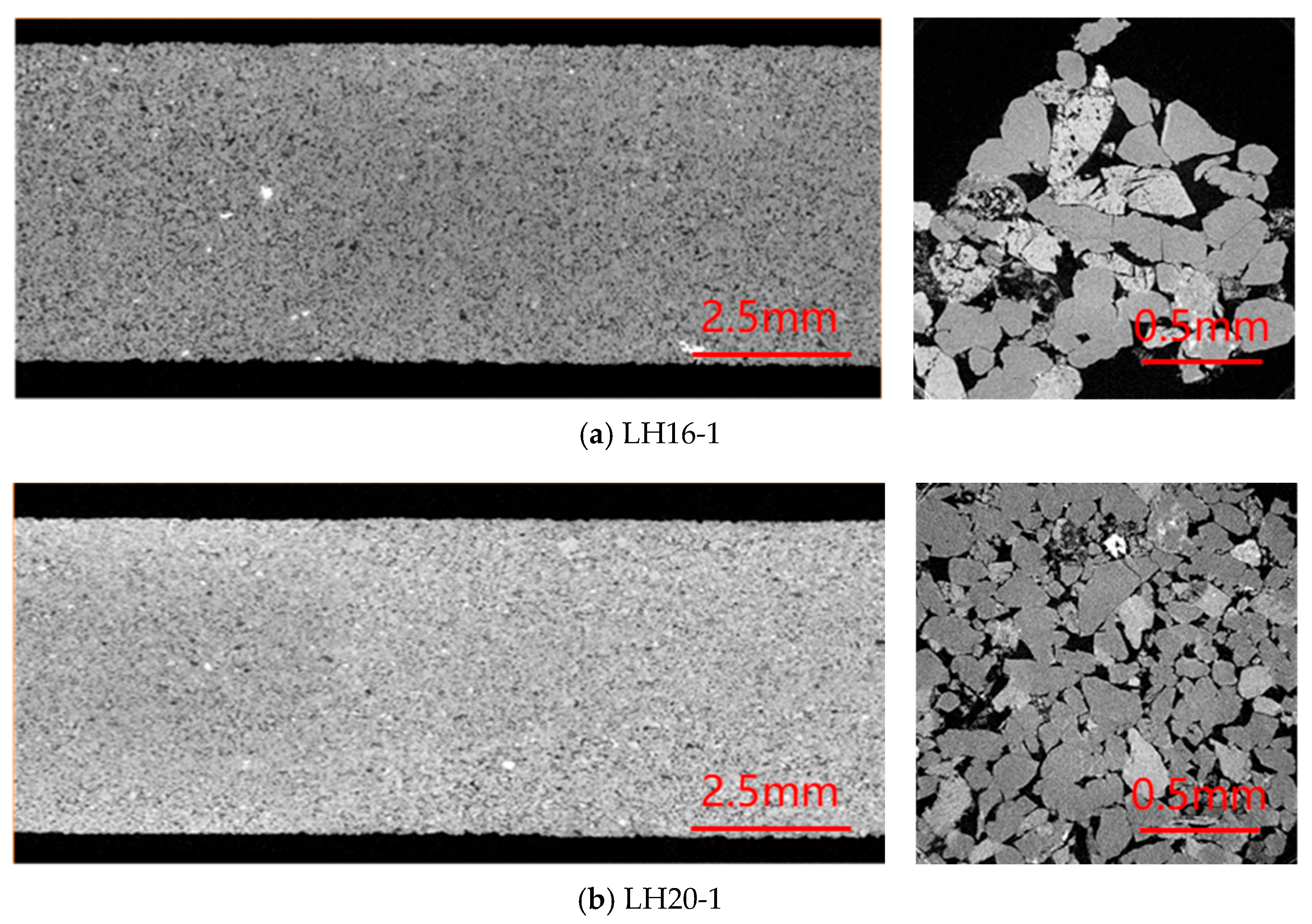
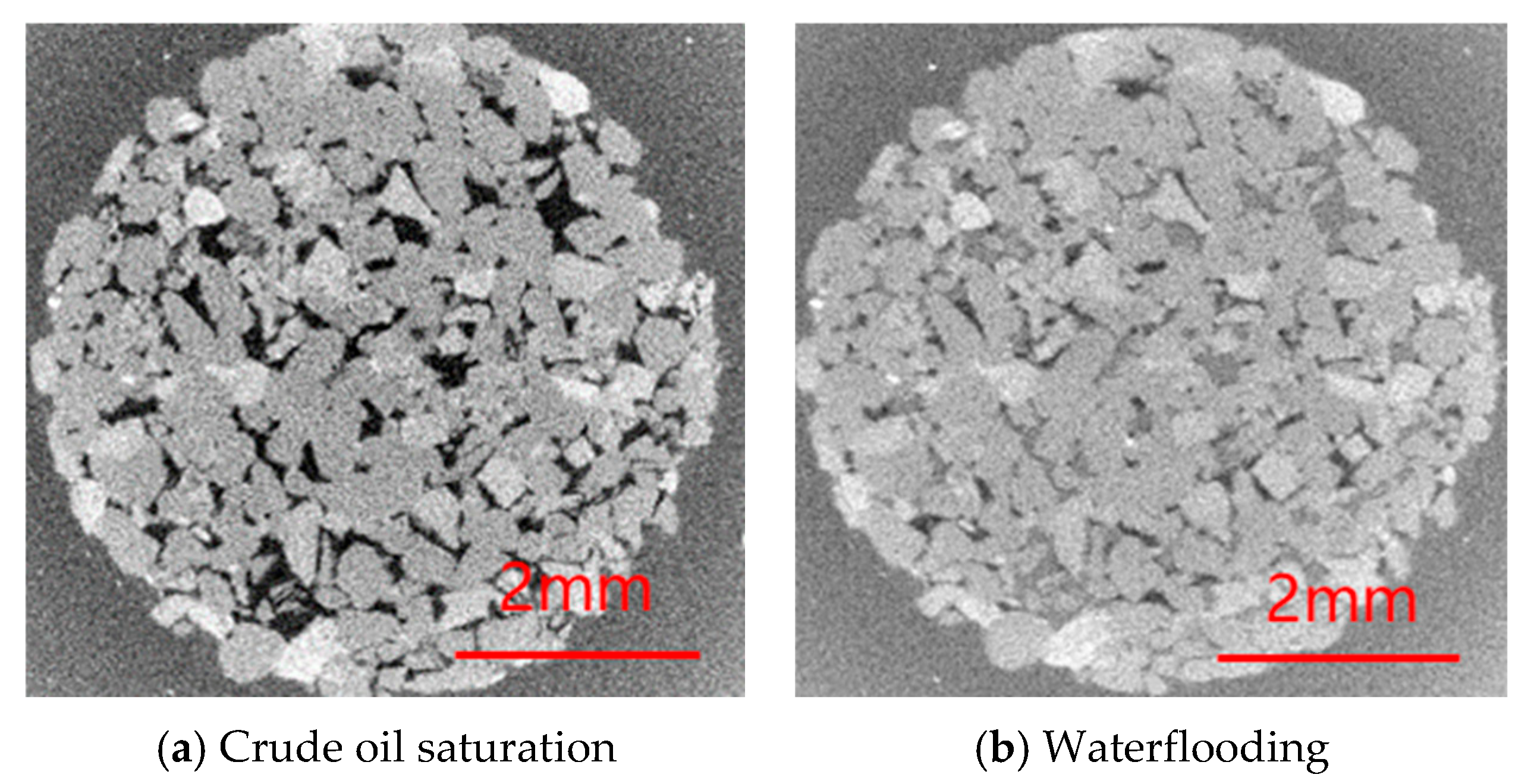




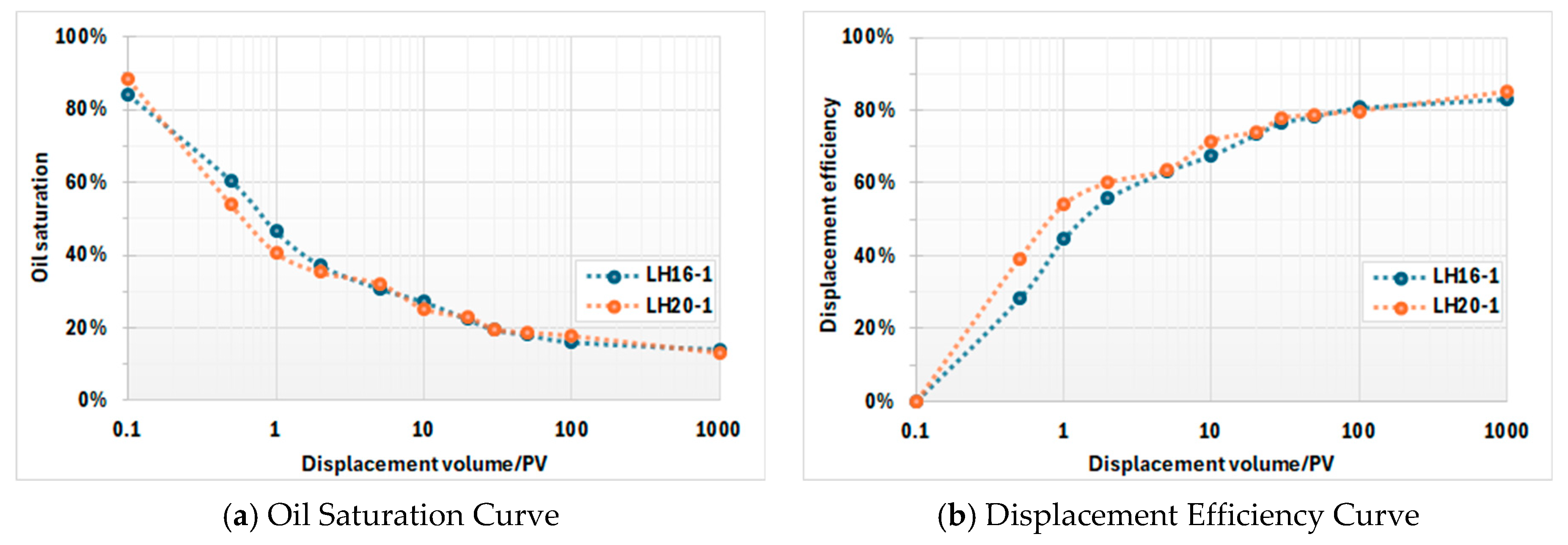
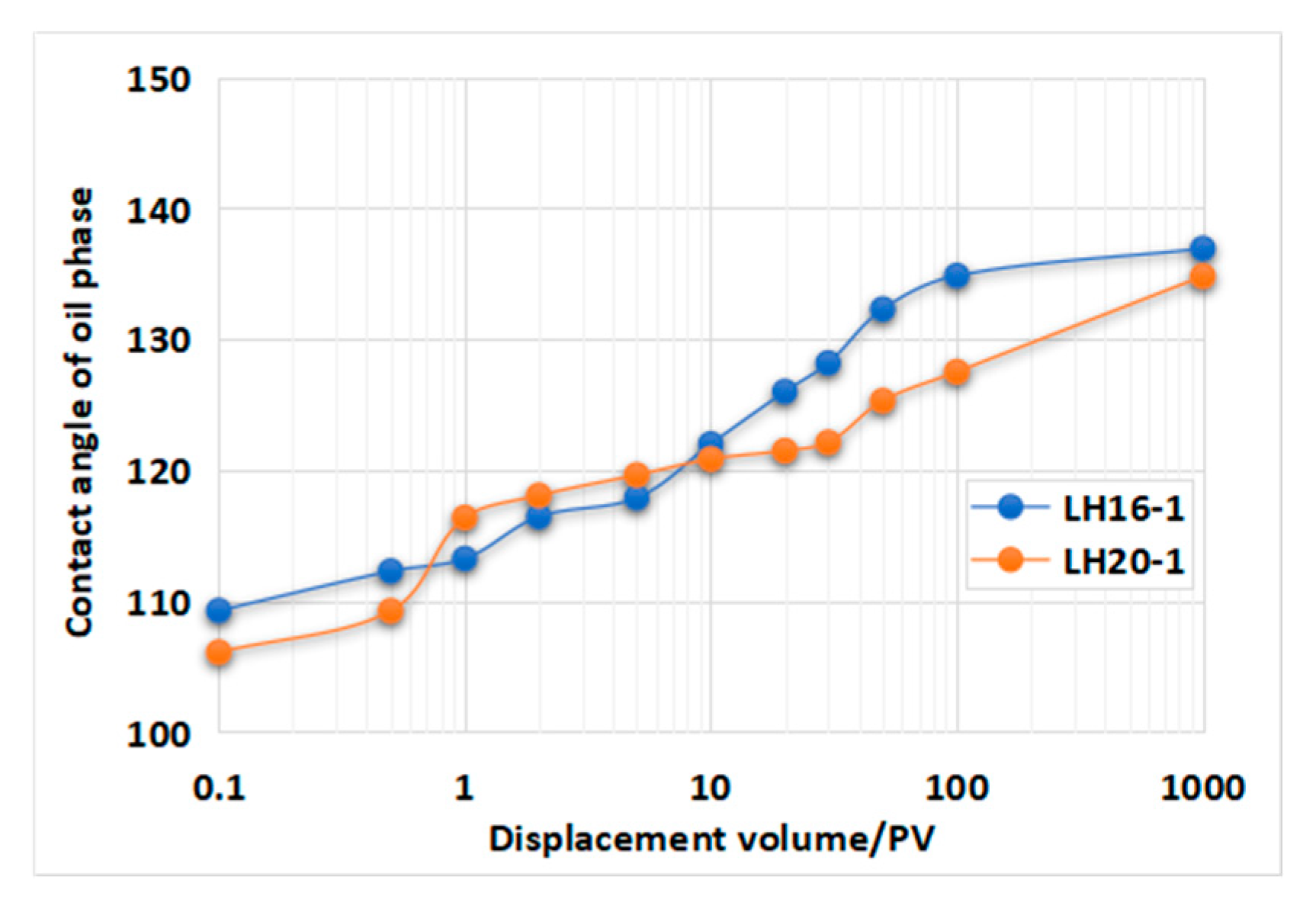


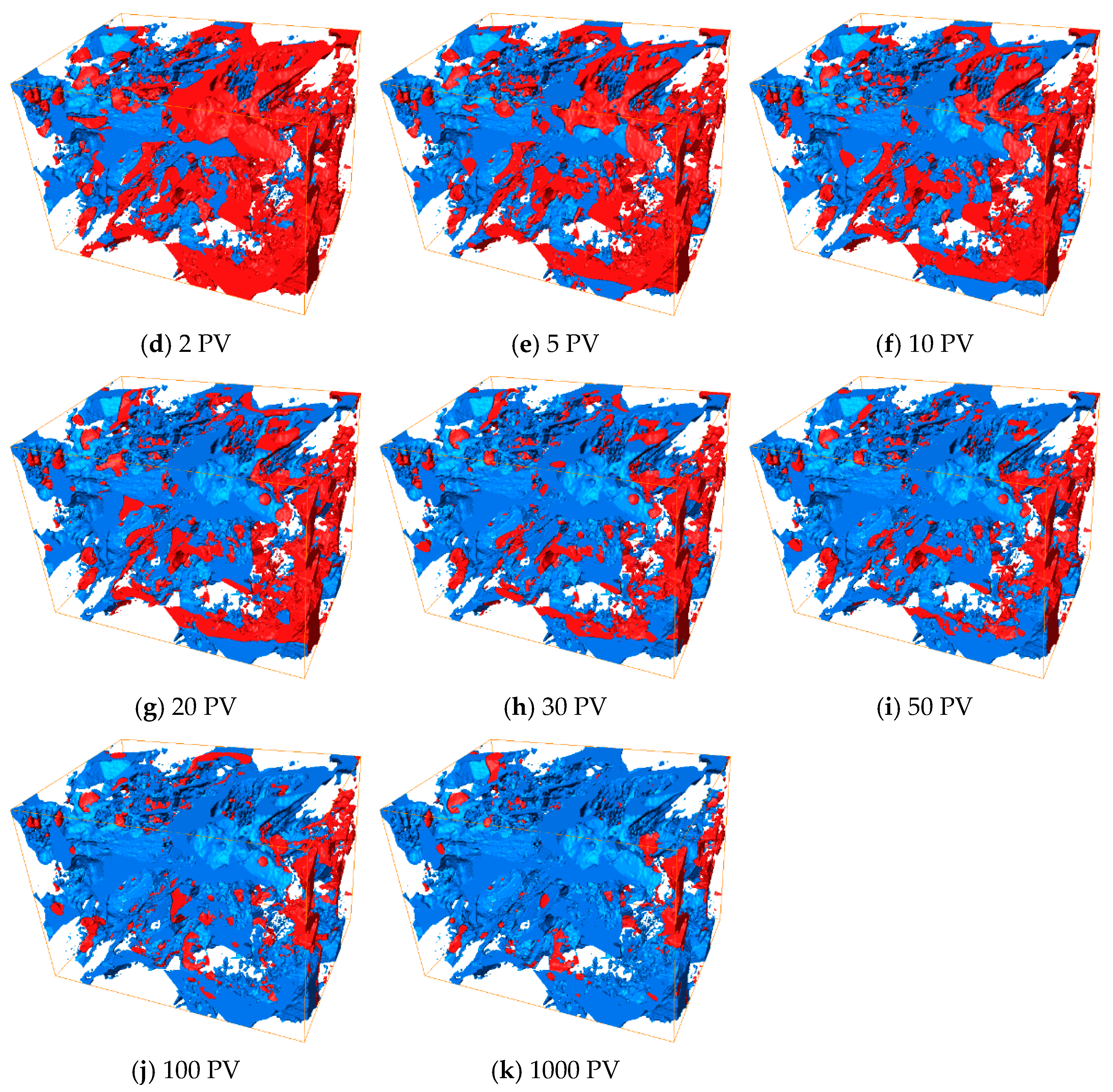
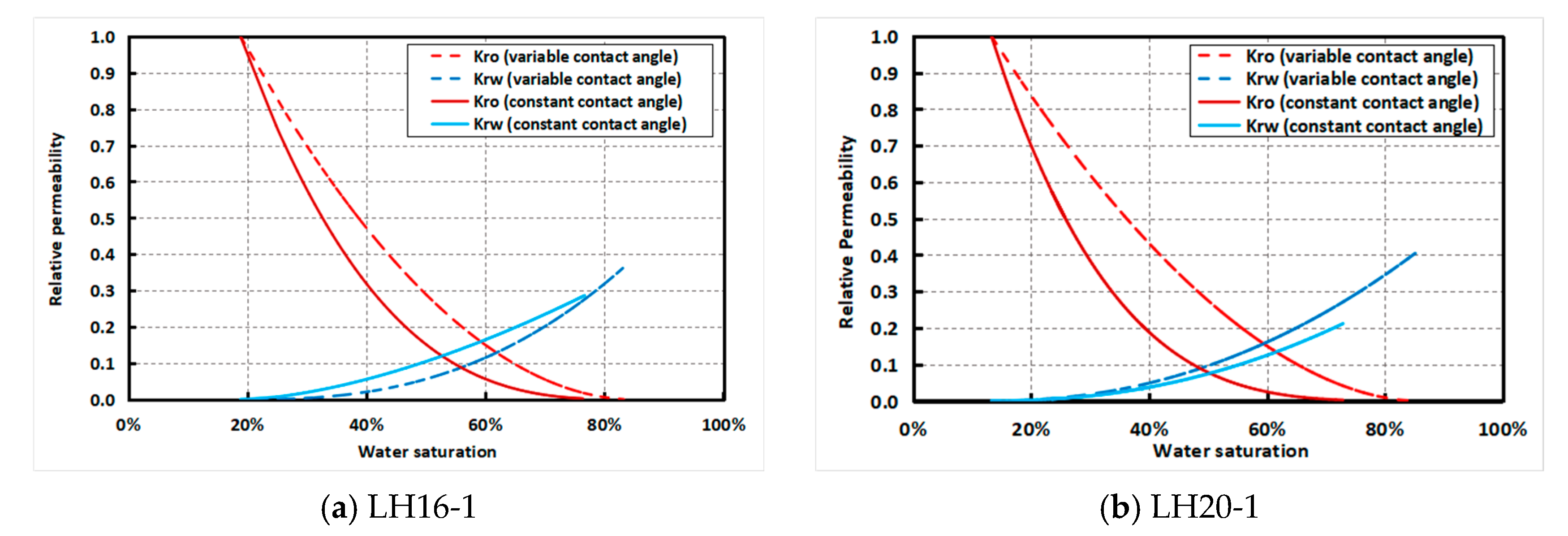

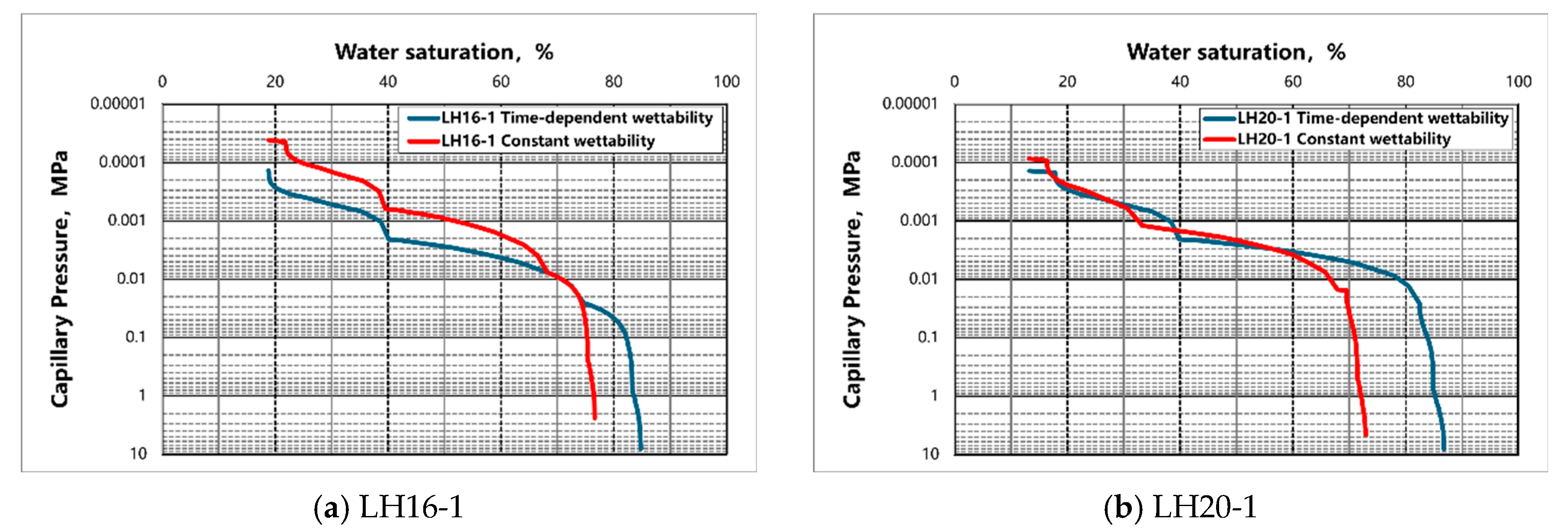
| Sample | Porosity ε, % | Permeability k, mD | Minerals | ||||
|---|---|---|---|---|---|---|---|
| Calcite | Dolomite | Quartz | Clay | Potassium Feldspar | |||
| LH16-1 | 23.32 | 1156.89 | 0 | 2.1 | 77.8 | 7.0 | 13.1 |
| LH20-1 | 23.12 | 1003.28 | 1.5 | 1.4 | 83.1 | 4.9 | 9.1 |
| Parameter | Value |
|---|---|
| Lattice resolution | 600 × 600 × 800 |
| Relaxation time τ | 1.0 |
| Water-to-oil density ratio | 1.92 |
| Fluid–fluid interaction strength | 0.65 |
| Fluid–solid interaction strength | Adjusted based on measured contact angle |
| Injection pressure gradient | 0.001 |
| Samples | Fitted Corey Correlation |
|---|---|
| LH16-2, constant wettability | |
| LH16-2, time-dependent wettability | |
| LH20-2, constant wettability | |
| LH20-2, time-dependent wettability |
Disclaimer/Publisher’s Note: The statements, opinions and data contained in all publications are solely those of the individual author(s) and contributor(s) and not of MDPI and/or the editor(s). MDPI and/or the editor(s) disclaim responsibility for any injury to people or property resulting from any ideas, methods, instructions or products referred to in the content. |
© 2025 by the authors. Licensee MDPI, Basel, Switzerland. This article is an open access article distributed under the terms and conditions of the Creative Commons Attribution (CC BY) license (https://creativecommons.org/licenses/by/4.0/).
Share and Cite
Liu, C.; Sun, C.; Dai, L.; Wang, G.; Shao, H.; Li, W.; Long, W. Integrating Laboratory-Measured Contact Angles into Time-Dependent Wettability-Adjusted LBM Simulations for Oil–Water Relative Permeability. Energies 2025, 18, 2404. https://doi.org/10.3390/en18092404
Liu C, Sun C, Dai L, Wang G, Shao H, Li W, Long W. Integrating Laboratory-Measured Contact Angles into Time-Dependent Wettability-Adjusted LBM Simulations for Oil–Water Relative Permeability. Energies. 2025; 18(9):2404. https://doi.org/10.3390/en18092404
Chicago/Turabian StyleLiu, Chenglin, Changwei Sun, Ling Dai, Guanqun Wang, Haipeng Shao, Wei Li, and Wei Long. 2025. "Integrating Laboratory-Measured Contact Angles into Time-Dependent Wettability-Adjusted LBM Simulations for Oil–Water Relative Permeability" Energies 18, no. 9: 2404. https://doi.org/10.3390/en18092404
APA StyleLiu, C., Sun, C., Dai, L., Wang, G., Shao, H., Li, W., & Long, W. (2025). Integrating Laboratory-Measured Contact Angles into Time-Dependent Wettability-Adjusted LBM Simulations for Oil–Water Relative Permeability. Energies, 18(9), 2404. https://doi.org/10.3390/en18092404





